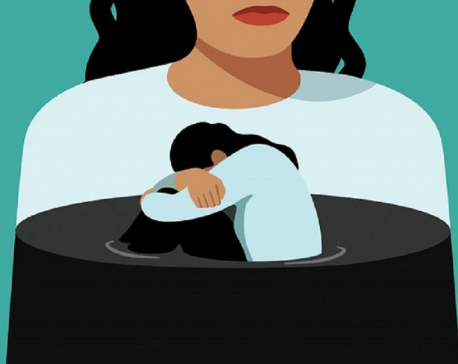
OR
Blog
Access to Mental Health Professionals in Nepal
Published On: November 3, 2022 02:15 PM NPT By: Mohit Rauniyar


Mohit Rauniyar
Rauniyar is the co-founder of Canopy Nepal and is a shaper at Global Shapers Kathmandu Hubnews@myrepublica.com
More from Author
In Nepal, only 0.36 psychiatrists work in the mental health sector per 100,000 population.
Earlier this year, I spoke to Chhaya (name changed to protect privacy), and she shared her recent experiences with me. Over the past couple of years, she went through a series of events that included the loss of one of her parents, a toxic relationship, a toxic workplace, an unsuccessful attempt to start a business, financial loss, familial disagreements, detachment, low self-esteem, and then the pandemic.
Chhaya started to see a psychiatrist who diagnosed her with clinical depression. The sessions continued. One session a week, session after session for nine months. The first half of the year was good. Chhaya was better able to manage her mental health challenges, and her life seemed to change for the good. Then came a plateau in her progress in the second year, where all progress stopped. Chhaya continued on. The treatment costs were high, leading her to dip more and more into her rapidly depleting savings. She increasingly felt the need to change her psychiatrist but did not know any other psychiatrist to turn to. Chhaya’s story is a painfully familiar but unspoken truth in our Nepali society.
Mental health includes our emotional, psychological, and social well-being. It affects how we think, feel, and act; and determines how we handle stress, relate to others, and make healthy choices. Mental health challenges are health conditions involving changes in emotion, thinking, or behavior (or a combination of these). These issues are associated with distress and/or problems functioning in social situations, work, or family activities. And like most physical health problems, it is possible to recover with the necessary support/guidance. There is no one road to recovery which may include self-care techniques, treatments, and psychiatric medications.
One in every 8 people in the world lives with a mental health challenge. The pandemic has contributed to the figure, increasing the global prevalence of anxiety and depression by 25 percent. Nepal is no different, where an estimated 2.2 million people, aged between 16-40 years, live with some form of mental health challenge. Further, a National Health Research Council study suggests that 94 percent of people with mental illnesses never reach out to consult a psychiatrist, psychologist, or therapist. A major reason for this hesitation is the stigma and cultural perception of mental health in Nepal and the wider South Asian community. Another contributing factor is also the poor access to quality mental health services.
Mental health services, like any medical service, should be easily accessible and should include services that are delivered uninterrupted, timely, safe, non-judgmental, and evidence-based. At the same time, it should take individual needs and preferences into account. After the pandemic, the number of people requiring mental health services has drastically risen. In Nepal, only 0.36 psychiatrists work in the mental health sector per 100,000 population. Chhaya had a bit of better luck when she had access to a psychiatrist and perhaps the financial means for it, but this is not the case for many people facing mental health challenges. A common concern amongst most is not knowing where to begin the recovery process and, later, the lack of access to the right kind of mental health professionals.
The cost associated with mental health services is another significant barrier. The National Mental Health Survey’s Fact Sheet in 2020 suggested that the yearly average expenditure on treatment of mental disorders was Rs 23,659 (including transportation and other associated costs). For a country with a GDP per capita of merely around USD1,223 (approximately Rs 155,000), it seems unlikely for citizens to allocate about 15 percent of their annual income to receiving mental health services. This adds strain to individuals who need regular mental health support but cannot afford the said services.
As a society, it is not only essential to promote and protect the well-being of all individuals but also to focus on people with mental health conditions. And the focus should be done by providing affordable quality mental health services along with awareness about mental health and its issues. Mental health services must be integrated into the healthcare systems and should be easily accessible in different forms across healthcare delivery service points across the country. Further, establishing community mental health centers with well-trained professionals is another step toward creating a good mental health service system. In practical terms, it could mean training community health volunteers to provide psychological first aid and serving to connect those in need with the right type of help.
An important point to remember is that mental health care should be inclusive, extending to child protection, prisons, and school health services as well. Unaddressed mental health problems cannot only have negative impacts on the individual but on the community as well. For that, it is important community members like Chhaya have easier and more affordable access to mental health services. And when the mental health needs of individuals are met, individuals and communities are bound to prosper. A recent uptick in organizations working on mental health marks a positive step ahead in addressing the challenge of finding mental health support in Nepal. What we need in the days ahead is a community-wide effort that should be led and supported by the Government of Nepal, which is the ultimate responsible body for fulfilling the healthcare needs of the Nepali population.
You May Like This

Safeguarding mental health during COVID-19
According to a survey conducted during this period of lockdown, suicide cases in Nepal have gone up by 20 percent.... Read More...

I found solace in art when depressed
“I figured out that something was wrong with me and went to get a diagnosis. My doctor told me to... Read More...

Why is International Men's Day celebrated?
Nov 19: While the world celebrates Women's Day with great pomp and celebrations, International Men's Day, celebrated on November 19,... Read More...

Just In
- Global oil and gold prices surge as Israel retaliates against Iran
- Sajha Yatayat cancels CEO appointment process for lack of candidates
- Govt padlocks Nepal Scouts’ property illegally occupied by NC lawmaker Deepak Khadka
- FWEAN meets with President Paudel to solicit support for women entrepreneurship
- Koshi provincial assembly passes resolution motion calling for special session by majority votes
- Court extends detention of Dipesh Pun after his failure to submit bail amount
- G Motors unveils Skywell Premium Luxury EV SUV with 620 km range
- Speaker Ghimire administers oath of office and Secrecy to JSP lawmaker Khan
















_20240419161455.jpg)
Leave A Comment